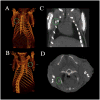Will nanotechnology influence targeted cancer therapy?
- PMID: 21356476
- PMCID: PMC3062202
- DOI: 10.1016/j.semradonc.2010.10.003
Will nanotechnology influence targeted cancer therapy?
Abstract
The rapid development of techniques that enable synthesis (and manipulation) of matter on the nanometer scale and the development of new nanomaterials will play a large role in disease diagnosis and treatment, specifically in targeted cancer therapy. Targeted nanocarriers are an intriguing means to selectively deliver high concentrations of cytotoxic agents or imaging labels directly to the cancer site. Often, solubility issues and an unfavorable biodistribution can result in a suboptimal response of novel agents even though they are very potent. New nanoparticulate formulations allow simultaneous imaging and therapy ("theranostics"), which can provide a realistic means for the clinical implementation of such otherwise suboptimal formulations. In this review, we did not attempt to provide a complete overview of the rapidly enlarging field of nanotechnology in cancer; rather, we presented properties specific to nanoparticles and examples of their uses, which show their importance for targeted cancer therapy.
Copyright © 2011 Elsevier Inc. All rights reserved.
Figures







References
-
- Feynman RP, Robbins J, Dyson FJ. The pleasure of finding things out. Cambridge, MA: Perseus Books; 1999.
-
- Eigler DM, Schweizer EK. Positioning single atoms with a scannin tunnelling microscope. Nature. 1990;344(6266):524–526.
-
- Cao G. Nanostructures & Nanomaterials: Synthesis, Properties & Applications. London: Imperial College Press; 2004.
-
- Gao L, Zhuang J, Nie L, et al. Intrinsic peroxidase-like activity of ferromagnetic nanoparticles. Nat Nanotechnol. 2007;2(9):577–83. - PubMed
Publication types
MeSH terms
Grants and funding
LinkOut - more resources
Full Text Sources

